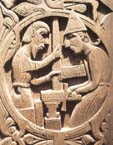 |
 |

Viking Iceland cradle of democracy About the Sagas living literature Vikings in America Project background Publication details Reviews Home |
Reviews ofThe Complete Sagas of IcelandersDr. Carolyne Larrington in The Times Literary Supplement, 34.6: 1998 "[...] Controversy over whether the sagas are history or fiction, or something between the two, whether they stem from traditional oral narratives or whether their genesis is purely literary, has been a major fixation of twentieth-century saga scholarship. The current consensus understands the sagas as literary works based on oral tradition and often dealing with verifiable historical events; their authors freely invent dialogue and detail in order to make the saga world come alive. Characteristically the saga plot is driven by feuds. The narrative voice simply reports events as they happen; praise or criticism of the behaviour of individuals is rarely ventured, though occasionally the narrator may relay the comments of the people of the district. The most popular sagas used to be much better known in the English-speaking world than they are today. When Auden and MacNeice journeyed to Iceland in 1936 they experienced the landscape as a palimpsest of events from the saga age: 'the bath of a great historian, the rock where / An outlaw dreaded the dark'. Following Auden and MacNeice, Simon Armitage and Glyn Maxwell visited Iceland in 1994; but the resulting book Moon Country is innocent of any curiosity about the island's past [...] These five volumes comprise all 39 sagas of Icelanders and 49 short tales, translated by English-speaking scholars. Each volume leads with one of the most important sagas of the corpus which sets the volume's theme. So vol. I contains sagas of poets, prefaced with a good general introduction and two sagas concerned with the North American settlement, II treats sagas of outlaws, vol. III is about 'champions and rogues'. The sagas of vols. IV and V mostly recount regional feuds. Vol. V also contains very useful explanatory notes, maps, indices and other information. This material, provided by the editorial team, tends to give preference to Icelandic views about, for example, dating of individual sagas, even where these conflict with international consensus. [...] The translations are generally excellent; accurate and readable, they are sure to become the standard versions. There is an overall consistency of tone which comes with the standardised translation of set phrases, yet in many sagas an noticeably individual tone still comes through. The translators have mostly avoided the twin perils of archaism and of raciness, while the verses which punctuate many of the sagas are skilfully and often wittily rendered. The poet Bjorn expresses his jealousy of his mistress (nicknamed Isle-Candle)'s husband and awareness of his own danger and discomfort sailing to Norway: 'Isle-candle's bunching buttocks / beat hard on the mattress / while we strive to stiffen / the supple oar ... on the gunwale'. Both the alliteration and the rueful humour of the original are captured. [...] At the end of volume five
one leaves an intensely-experienced world, comparable in realistic effect with
Hardy or Dickens. The reader learns the codes of this honour-driven society; key
scenes, like the burning of Njal and his sons in their home by Flosi, a fundamentally
decent man, gain impact from seeing how often in other sagas the option of burning
is rejected as dishonourable. This sense of immersion in another world is the
chief attraction of the Complete Sagas; also compelling are strongly-drawn characters
like Onund Tree-foot, 'the bravest and nimblest one-legged man ever to live in
Iceland', the mysterious, doomed Thorgunna, the witty poets Hallfred and Bjorn,
or the passionate and self-willed Gudrun. Nor are the sagas only about violent
feuding; some, like the Saga of the Confederates and many of the shorter tales,
are highly comic; the Saga of Viglund is a touching romance. When the publishers
can find a viable way of mass-marketing the set the sagas may yet regain their
rightful place in European literary culture. " [ <<
back ] |
"At the end of volume five one leaves an intensely-experienced world, comparable in realistic effect with Hardy or Dickens." "The translations are generally excellent; accurate and readable, they are sure to become the standard versions." 
|
 © Leifur Eiriksson Publishing Ltd.
© Leifur Eiriksson Publishing Ltd.Flokagata 65 – 105 Reykjavik – Iceland Tel: (354) 552-8989 – E-mail: vinland@centrum.is |
||